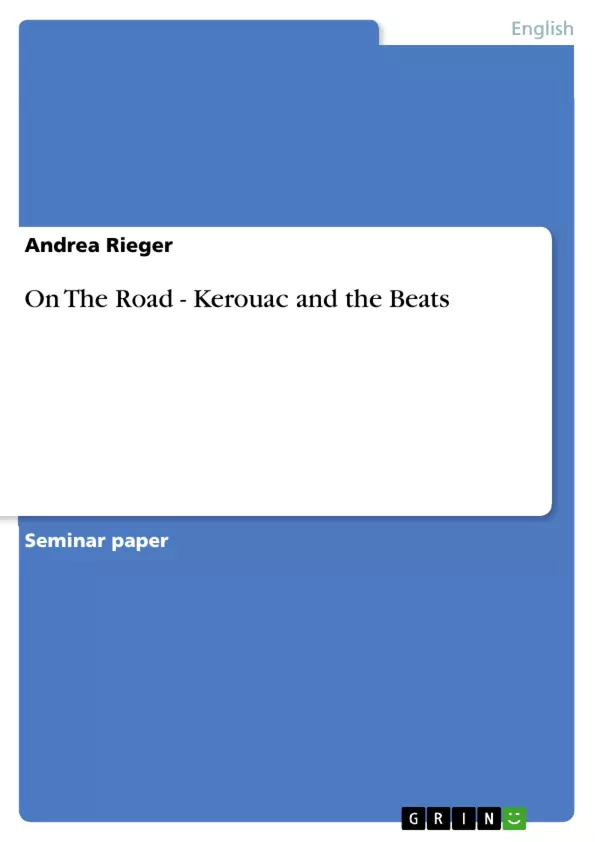Introduction .
Practically all of Kerouac's books are said to be autobiographical(1) . In my seminar paper I draw a comparison between the real life of Kerouac and his Beat colleagues and the events depicted in his novel “On the Road”. In order to do so, I focus on the biographies of both Jack Kerouac and Neal Cassady, whose personas build the main characters Sal and Dean. Furthermore, I illustrate the Beat movement – how it came into existence and why – and the attitudes within the Beat Generation. This is of importance to show that Kerouac’s novel “On the Road” not only stands within the tradition of the Beat movement but also defined it.
Another focus is on the development of the novel’s main characters which consequently leads to the question of the meaning of journey in the novel. I demonstrate that at different stages the main characters had different motifs for travelling. In addition, I also show that the journeys changed with the progress of the plot.
[...]
______
1 cf. Seymour Krim, “Introduction“. Jack Kerouac. Desolation Angels. New York: Coward-McCann, 1965. xxii.
Inhaltsverzeichnis (Table of Contents)
- Introduction
- 1. The Biographies of Two Travellers
- 1.1 Jack Kerouac
- 1.2 Neal Cassady
- 2. Other Travellers - 'The Beats' & their Generation
- 2.1 Drugs
- 2.2 Jazz and Bebop
- 3. Their Story – 'On the Road'
- 4. The Two Main Travellers in the Novel
- 4.1 Dean Moriarty
- 4.2 Sal Paradise
- 4.2.1 Sal's language
- 5. Other Characters
- 5.1 The unnamed aunt
- 5.2 Old Bull Lee
- 5.3 Carlo Marx
- 5.4 Camille
- 6. The Meaning of their Journeys
Zielsetzung und Themenschwerpunkte (Objectives and Key Themes)
This seminar paper aims to compare the real lives of Jack Kerouac and his Beat colleagues with the events depicted in his novel "On the Road". The paper focuses on the biographies of Jack Kerouac and Neal Cassady, whose personas form the main characters Sal and Dean. It further explores the Beat movement – its origins, motivations, and defining attitudes – demonstrating how Kerouac's novel "On the Road" both reflects and shapes this literary movement.
- The biographies of Jack Kerouac and Neal Cassady
- The origins and characteristics of the Beat movement
- The development of the novel's main characters
- The meaning and evolution of journeys in the novel
- The impact of Kerouac's novel "On the Road" on the Beat movement
Zusammenfassung der Kapitel (Chapter Summaries)
The introduction provides an overview of the paper's scope and objectives, outlining the focus on comparing the real lives of Kerouac and Cassady with their fictional counterparts in "On the Road".
Chapter 1 delves into the biographies of Jack Kerouac and Neal Cassady. It highlights their early lives, influences, and encounters that shaped their personalities and artistic pursuits. The chapter traces their journeys through education, military service, and early literary aspirations.
Chapter 2 explores the Beat movement, its origins, and defining characteristics. The chapter examines the role of drugs, jazz and bebop music in the Beat generation's countercultural spirit.
Chapter 3 provides an overview of Kerouac's novel "On the Road", positioning it within the context of the Beat movement and emphasizing the novel's significance in shaping the movement's identity.
Chapter 4 examines the development of the two main characters in the novel, Dean Moriarty and Sal Paradise, exploring their motivations for travelling and the evolution of their journeys throughout the narrative.
Chapter 5 introduces other key characters in the novel, including the unnamed aunt, Old Bull Lee, Carlo Marx, and Camille. The chapter briefly outlines their roles and interactions with the main characters, providing a broader understanding of the novel's social and interpersonal dynamics.
Chapter 6 delves into the meaning of the journeys undertaken by the characters, examining their motivations, experiences, and the impact these journeys have on their personal growth and perspectives.
Schlüsselwörter (Keywords)
The main keywords and focus topics of the paper are Jack Kerouac, Neal Cassady, "On the Road", Beat movement, Beat generation, counterculture, autobiography, biography, literary influence, spontaneous prose, journey, character development, and personal growth.
- Citar trabajo
- Andrea Rieger (Autor), 2001, On The Road - Kerouac and the Beats, Múnich, GRIN Verlag, https://www.grin.com/document/895



